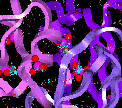 Molecular Dynamics -
Statistical Ensembles
Molecular Dynamics -
Statistical Ensembles
Contents
Although integrating Newton's
equations of motion allows you to explore the constant-energy
surface of a system, you may want to keep the temperature and pressure
of the system constant during the molecular simulation, to mimic
experimental conditions.
The Discover program provides several methods for controlling
temperature and pressure. Depending on which state variables (for
example, the energy E, volume V, temperature T,
pressure P, and number of particles N) are kept fixed,
different statistical ensembles can be generated. A variety of
structural, energetic, and dynamic properties can then be calculated
from the averages or the fluctuations of these quantities over the
ensemble generated.
In the Discover 2.9.5 program, the available ensembles are:
In the Discover 95.0 program, the available ensembles are:
In all ensembles, the number of particles is conserved.
Since the ensembles are artificial constructs, they produce averages
that are consistent with one another when they represent the same
state of the system. Nevertheless, the fluctuations vary in different
ensembles. Some of the fluctuations are related to thermodynamic
derivatives, such as the specific heat or the isothermal
compressibility. In practice, obtaining accurate fluctuations to
calculate physical quantities is difficult, and this approach should
be used with caution. The transformation and relation between
different ensembles has been discussed in greater detail by Allen and Tildesley (1987).
The constant-energy, constant-volume ensemble (NVE), also known as the
microcanonical ensemble, is obtained by solving Newton's equation without any
temperature and pressure control. Energy is conserved when this
ensemble is generated. However, because of rounding and truncation
errors during the integration process, there is always a slight drift
in energy. In the Verlet leapfrog algorithm, only r(t)
and v(t - 1/2 t) are
known at each timestep. Thus, the potential and kinetic energies at
each timestep are also half a step out of synchrony. Although the
difference between the kinetic energies half a timestep apart is
small, this also contributes to the fluctuation in the total
energy.
t) are
known at each timestep. Thus, the potential and kinetic energies at
each timestep are also half a step out of synchrony. Although the
difference between the kinetic energies half a timestep apart is
small, this also contributes to the fluctuation in the total
energy.
Constant-energy simulations are not recommended for equilibration
because, without the energy flow facilitated by the temperature
control methods, the desired temperature cannot be achieved. However,
during the data collection phase, if you are interested in exploring
the constant-energy surface of the conformational space, or, for other
reasons do not want the perturbation introduced by temperature- and
pressure-bath coupling, this is a useful ensemble.
The constant-temperature, constant-volume ensemble (NVT), also
referred to as the canonical ensemble, is the default ensemble
provided in the Discover program. The ensemble is obtained by
controlling the temperature through direct temperature scaling during
the initialization stage and by temperature-bath coupling during the
data collection phase. The volume is kept constant throughout the
run. This is the appropriate choice when conformational searches of
molecules are carried out in vacuum without periodic boundary
conditions. Without periodic boundary conditions, volume, pressure,
and density are not defined. Constant-pressure dynamics cannot be
carried out. Even if periodic boundary conditions are used, if
pressure is not a significant factor the constant-temperature
constant-volume ensemble provides the advantage of less perturbation
of the trajectory, due to the absence of coupling to a pressure
bath.
The constant-temperature, constant-pressure ensemble (NPT) allows
control over both the temperature and pressure. The unit cell vectors
are allowed to change, and the pressure is adjusted by adjusting the
volume. This is the ensemble of choice when the correct pressure,
volume, and densities are important in the simulation. This ensemble
can also be used during equilibration to achieve the desired
temperature and pressure before changing to the constant-volume or
constant-energy ensemble when data collection starts.
The constant-temperature, constant-stress ensemble (NST) is an
extension of the constant-pressure ensemble. In
addition to the hydrostatic pressure which is applied isotropically,
constant-stress ensemble allows you to control the xx,
yy, zz, xy, yz, and zx components
of the stress tensor (sometimes also known as the pressure
tensor). This ensemble is particularly useful if you want to study the
stress-strain relationship in polymeric or metallic materials.
The constant-pressure, constant-enthalpy ensemble (NPH) is the
analogue of constant-volume, constant-energy
ensemble. Enthalpy H, which is the sum of E and
PV, is constant when the pressure is kept fixed without any
temperature control.
 Main
access page
Main
access page  Theory/Methodology access.
Theory/Methodology access.
 Dynamics access
Dynamics access
 Dynamics - Stages & Duration of Runs
Dynamics - Stages & Duration of Runs
 Dynamics - Temperature
Dynamics - Temperature
Copyright Biosym/MSI
 Molecular Dynamics -
Statistical Ensembles
Molecular Dynamics -
Statistical Ensembles Molecular Dynamics -
Statistical Ensembles
Molecular Dynamics -
Statistical Ensembles Main
access page
Main
access page  Theory/Methodology access.
Theory/Methodology access.  Dynamics access
Dynamics access
 Dynamics - Stages & Duration of Runs
Dynamics - Stages & Duration of Runs
 Dynamics - Temperature
Dynamics - Temperature